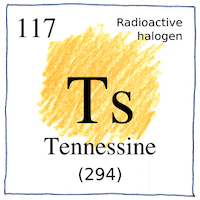Tennessine
Russian and American scientists collaborated in Dubna to synthesize element 117, the heaviest halogen. The team obtained berkelium-249 from Tennessee and sent it to Dubna, which is a story in itself. In Dubna, they bombarded the berkelium with calcium-48 and sent the data to the United States. Analysis showed the synthesis of two isotopes of element 117, tennessine-293 and tennessine-294. Tennessine decays to moscovium and moscovium decays to nihonium, which where both unknown so they delayed their claim. The team at Dubna repeated the experiment in 2012, although most of their berkelium had decayed to californium. Scientists at Darmstadt also repeated the experiment and got the same results, confirming the discovery.
Atomic number 117
Tennessine is predicted to be a solid volatile post-transition metal, but its half life is too short to confirm this. Spin-orbit interaction, stabilization of electrons, and subshell splitting are theorized to affect its ability to participate in chemical reactions.
Further work
A slight increase in the half lives of tennessine isotopes, compared to predicted values, is grounds for hope that even heavier isotopes would further the trend and eventually enable the production of something useful.




Production of californium for a commercial order using the Oak Ridge National Laboratory high-flux reactor in Tennessee allowed the separation of berkelium-249 for the production of tennessine in Dubna. After successfully synthesizing tennessine and enough of the bekelium-249 had decayed to californium-249, the scientists at Dubna were able to confirm their earlier synthesis of oganesson.
See also in The book of science:
Readings in wikipedia:
Other readings: